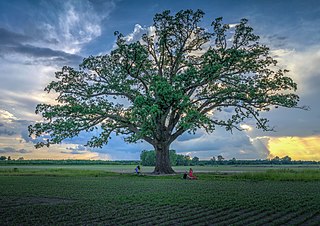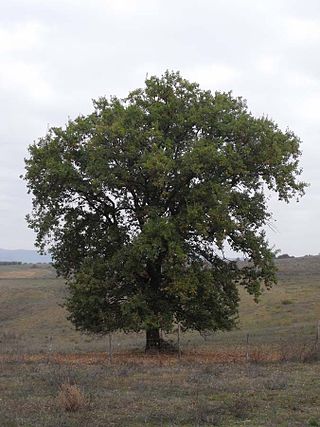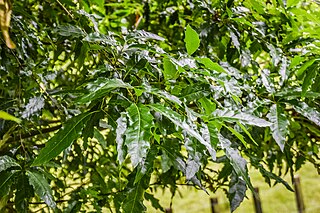
Quercus petraea, commonly known as the sessile oak, Cornish oak, Irish Oak or durmast oak, is a species of oak tree native to most of Europe and into Anatolia and Iran. The sessile oak is the national tree of Ireland, and an unofficial emblem in Wales and Cornwall.

Quercus macrocarpa, the bur oak or burr oak, is a species of oak tree native to eastern North America. It is in the white oak section, Quercus sect. Quercus, and is also called mossycup oak, mossycup white oak, blue oak, or scrub oak. The acorns are the largest of any North American oak, and are important food for wildlife.

Quercus pubescens, commonly known as the downy oak, pubescent oak or Italian oak, is a species of white oak native to southern Europe and southwest Asia. It is found from northern Spain (Pyrenees) and France in the West to Turkey and the Caucasus in the East.

Quercus coccifera, the kermes oak, is an oak bush in the Ilex section of the genus. It has many synonyms, including Quercus calliprinos. It is native to the Mediterranean region and Northern African Maghreb, south to north from Morocco to France and west to east from Portugal to Cyprus and Turkey, crossing Spain, Italy, Libya, Balkans, and Greece, including Crete. The Kermes Oak was historically important as the food plant of Kermes scale insects, from which a red dye called crimson was obtained. The etymology of the specific name coccifera is related to the production of red cochineal (crimson) dye and derived from Latin coccum which was from Greek κόκκος, the kermes insect. The Latin -fera means 'bearer'.

Quercus faginea, the Portuguese oak, is a species of oak native to the western Mediterranean region in the Iberian Peninsula. Similar trees in the Atlas Mountains of northwest Africa are usually included in this species, or sometimes treated as a distinct species, Quercus tlemcenensis. It occurs in mountains from sea level to 1,900 metres above sea level, and flourishes in a variety of soils and climates. Out of all the oak forests in the Iberian Peninsula, the southern populations of Portuguese oak were found to have the highest diversity and endemism of spider species.

Quercus germana, the Mexican royal oak, is a species of oak tree in the family Fagaceae. It is native to mountain cloud forests in eastern Mexico. It is placed in section Quercus.
Quercus tardifolia, the Chisos Mountains oak or lateleaf oak, is a rare North American species of oak. It has been found in the Chisos Mountains inside Big Bend National Park in Texas, and in the nearby Sierra del Carmen across the Río Grande in northern Coahuila.

Quercus xalapensis, or xalapa oak, is a species of oak in the red oak group. It is native to the mountains of eastern and southern Mexico, as well as Guatemala, Honduras, and Nicaragua in northern Central America.

Quercus lusitanica, commonly known as gall oak, Lusitanian oak, or dyer's oak, is a species of oak native to Portugal, Spain and Morocco. Quercus lusitanica is the source of commercial nutgalls. These galls are produced by the infection from the insect Cynips gallae tinctoriae. They are used for dyeing.

Quercus mongolica, commonly known as Mongolian oak, is a species of oak native to Japan, China, Korea, Mongolia, and Siberia. The species can grow to be 30 metres tall.

Quercus ithaburensis, the Mount Tabor oak, is a tree in the beech family Fagaceae. It is found from southeastern Italy to the Levant. It is the national tree of Jordan. Two subspecies are accepted, Quercus ithaburensis subsp. ithaburensis and Quercus ithaburensis subsp. macrolepis. Together with Quercus brantii, it forms a clade of distinct, closely related species within the oak section Cerris.

Quercus acuta, the Japanese evergreen oak, is an oak native to Japan, South Korea, Taiwan, and China's Guizhou Province and Guangdong Province. It is placed in subgenus Cerris, section Cyclobalanopsis.

Quercus rotundifolia, the holm oak or ballota oak, is an evergreen oak native to the western Mediterranean region, with the majority on the Iberian Peninsula and minor populations in Northwest Africa. The species was first described by Jean-Baptiste Lamarck in 1785. It is the typical species of the Iberian dehesa or montado, where its sweet-astringent acorns are a source of food for livestock, particularly the Iberian pig. Its acorns have been used for human nourishment since the Neolithic era. It is placed in section Ilex. Some authors described it as a subspecies of Quercus ilex.

Quercus geminata, commonly called sand live oak, is an evergreen oak tree native to the coastal regions of the subtropical southeastern United States, along the Atlantic Coast from southern Florida northward to southeastern Virginia and along the Gulf Coast westward to southern Mississippi, on seacoast dunes and on white sands in evergreen oak scrubs.

Quercus laurina is a species of oak. It is native primarily to Mexico and has also been found in Guatemala and El Salvador.

Quercus pyrenaica, also known as Pyrenean oak, or Spanish oak is a tree native to southwestern Europe and northwestern North Africa. Despite its common name, it is rarely found in the Pyrenees Mountains and is more abundant in northern Portugal and north and northwestern Spain.

Quercus brantii, Brant's oak, is a species of oak native to Western Asia, namely in Iran, Iraq, Syria, and Turkey.

Quercus canbyi, synonyms including Quercus graciliformis, is a North American species of oak tree.

Quercus vulcanica is a species of flowering plant in the Fagaceae family. It is referred to by the common name Kasnak oak, and is a rare species of tree native to Lebanon, Syria, and Turkey. It is placed in section Quercus.

Quercus pringlei is a species of oak native to northeastern Mexico.




















